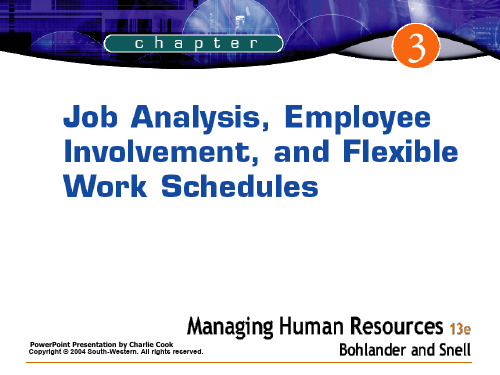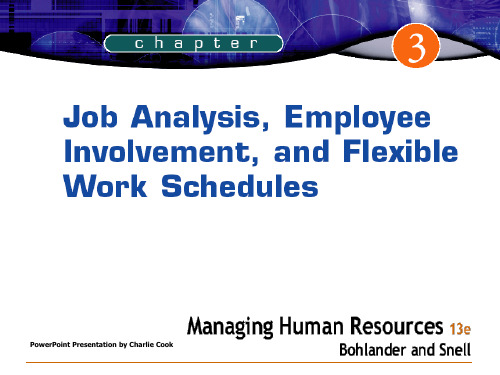工作分析(英文PPT57
合集下载
工作分析ppt课件 (5)

③在工作中所使用的机器、工具、设备以及工作辅助用品,如电话、计算机、传 真机、汽车、对讲机、仪器以及车床等等。
④与工作有关的有形和无形因素,包括完成工作所要涉及或者要运用的知识,如 公司的会计需要运用会计方面的知识,法律事务主管需要懂得法律知识等;工作 中所加工处理的材料;所生产的产品或提供的服做?
这就需要进行岗位分析,确定职责!
第一节 工作分析概述
一、工作分析的含义
工作分析(job analysis)─也可以叫做职位分析、岗位分析,
它是指了解组织内的一种职位并以一种格式把与这种职位有关的信 息描述出来,从而使其他人能了解这种职位的过程。具体来说,工 作分析就是要为管理活动提供与工作有关的各种信息,这些信息可 以用“6W1H”加以概括 。
完成阶段
1.准备阶段
(1)确定工作分析的目的和用途。 (2)成立工作分析小组。 (3)对工作分析人员进行培训。 (4)做好其他必要的准备。
一、工作分析的步骤
2.调查阶段
(1)制定工作分析的时间计划进度表。 (2)根据目的选择搜集工作内容及相关信息的方法。 (3)搜集工作的背景资料。 (4)搜集职位的相关信息
⑤工作绩效的信息,如完成工作所耗费的时间、所需要投入的成本以及工作中出 现的误差等等。需要注意的是,这里只是搜集与绩效相关的信息,并不是要制定 与各项工作相对应的绩效目标,后者是分析阶段所要完成的任务。
⑥工作的背景条件,包括个人时间;工作的地点,如是在室内还是在室外;工作 的物理条件,如有没有噪音、是不是在高温条件下等等。
有关领导看了投诉以后,审阅了这三类人员的任职说明书:机 床操作工、服务工和勤杂工。机床操作工的任职说明书规定:操作 工有责任保持机床的清洁,使之处于可操作的状态,但并未提及清 扫地板;服务工的任职说明书规定:服务工有责任以各种方式协助 操作工,如领取原料和工具,随叫随到,即时服务,但也没有包括 清扫工作;勤杂工的任职说明书里确实包括了各种形式的清扫工作, 但他的工作时间是从正常工人下班以后开始。
④与工作有关的有形和无形因素,包括完成工作所要涉及或者要运用的知识,如 公司的会计需要运用会计方面的知识,法律事务主管需要懂得法律知识等;工作 中所加工处理的材料;所生产的产品或提供的服做?
这就需要进行岗位分析,确定职责!
第一节 工作分析概述
一、工作分析的含义
工作分析(job analysis)─也可以叫做职位分析、岗位分析,
它是指了解组织内的一种职位并以一种格式把与这种职位有关的信 息描述出来,从而使其他人能了解这种职位的过程。具体来说,工 作分析就是要为管理活动提供与工作有关的各种信息,这些信息可 以用“6W1H”加以概括 。
完成阶段
1.准备阶段
(1)确定工作分析的目的和用途。 (2)成立工作分析小组。 (3)对工作分析人员进行培训。 (4)做好其他必要的准备。
一、工作分析的步骤
2.调查阶段
(1)制定工作分析的时间计划进度表。 (2)根据目的选择搜集工作内容及相关信息的方法。 (3)搜集工作的背景资料。 (4)搜集职位的相关信息
⑤工作绩效的信息,如完成工作所耗费的时间、所需要投入的成本以及工作中出 现的误差等等。需要注意的是,这里只是搜集与绩效相关的信息,并不是要制定 与各项工作相对应的绩效目标,后者是分析阶段所要完成的任务。
⑥工作的背景条件,包括个人时间;工作的地点,如是在室内还是在室外;工作 的物理条件,如有没有噪音、是不是在高温条件下等等。
有关领导看了投诉以后,审阅了这三类人员的任职说明书:机 床操作工、服务工和勤杂工。机床操作工的任职说明书规定:操作 工有责任保持机床的清洁,使之处于可操作的状态,但并未提及清 扫地板;服务工的任职说明书规定:服务工有责任以各种方式协助 操作工,如领取原料和工具,随叫随到,即时服务,但也没有包括 清扫工作;勤杂工的任职说明书里确实包括了各种形式的清扫工作, 但他的工作时间是从正常工人下班以后开始。
工作分析和工作计划英文版

Introduction
Definition of Work Analysis
Work Analysis is a process of studying the nature, characteristics, and requirements of work tasks.
It involves breaking down work into its constituent elements and analyzing them to understand their relationships and dependencies.
Identifies the human, technical, and material resources required for project execution.
Identifies potential risks and how they will be mitigated or managed.
Case Study 2: Work Plan in a Software Development Project
总结词
需求分析、时间管理、团队协作
详细描述
在软件开发项目中,制定详细的工作计划至关重要。首先,进行需求分析,明确软件的 功能和性能要求,为后续开发提供依据。其次,做好时间管理,根据项目复杂度和团队 能力,合理安排开发进度,确保项目按时交付。此外,加强团队协作,通过有效的沟通
Analyze work: Break down the project into smaller, manageable tasks and analyze the effort required for each task.
Prioritize tasks:
Definition of Work Analysis
Work Analysis is a process of studying the nature, characteristics, and requirements of work tasks.
It involves breaking down work into its constituent elements and analyzing them to understand their relationships and dependencies.
Identifies the human, technical, and material resources required for project execution.
Identifies potential risks and how they will be mitigated or managed.
Case Study 2: Work Plan in a Software Development Project
总结词
需求分析、时间管理、团队协作
详细描述
在软件开发项目中,制定详细的工作计划至关重要。首先,进行需求分析,明确软件的 功能和性能要求,为后续开发提供依据。其次,做好时间管理,根据项目复杂度和团队 能力,合理安排开发进度,确保项目按时交付。此外,加强团队协作,通过有效的沟通
Analyze work: Break down the project into smaller, manageable tasks and analyze the effort required for each task.
Prioritize tasks:
基础工作分析(英文)

impact) New Jobs Jobs affected by new technology, expanded jobs, or
altogether new jobs Entry level jobs
performed by an individual. Responsibility: an obligation to perform certain tasks and duties. Position: set of tasks and duties performed by single individual
A group of related activities and duties
Job Family: A group of individual jobs with similar characteristics Occupation: general class of jobs Career: sequence of jobs held by individual throughout lifetime
The different duties and responsibilities performed by only one employee
Job: group of positions that are identical with respect to their major significant tasks and sufficiently alike to be covered by single analysis
Producing the job description (task, duties, and responsibilities) and job specification (KSAOs)
altogether new jobs Entry level jobs
performed by an individual. Responsibility: an obligation to perform certain tasks and duties. Position: set of tasks and duties performed by single individual
A group of related activities and duties
Job Family: A group of individual jobs with similar characteristics Occupation: general class of jobs Career: sequence of jobs held by individual throughout lifetime
The different duties and responsibilities performed by only one employee
Job: group of positions that are identical with respect to their major significant tasks and sufficiently alike to be covered by single analysis
Producing the job description (task, duties, and responsibilities) and job specification (KSAOs)
工作分析与工作计划英文版

Method
Job breakdown structure, critical success factors
Determine Job Requirements
Requirements Identification
Determining the skills, knowledge, and abilities necessary for performing the job effectively
Determine the main objectives and expected outcomes of the project, ensuring that team members have a clear understanding of the project objectives.
Ensure project objectives align with organizational and business objectives to achieve greater value.
Methodology
Discussions with stakeholders, review of organizational documents, and job shadowing
Collect Job Information
Information Gathering
Acquiring details about the job's daily activities, tasks, and responsibilities
Output
Job description, job profile, competency model
03
Job breakdown structure, critical success factors
Determine Job Requirements
Requirements Identification
Determining the skills, knowledge, and abilities necessary for performing the job effectively
Determine the main objectives and expected outcomes of the project, ensuring that team members have a clear understanding of the project objectives.
Ensure project objectives align with organizational and business objectives to achieve greater value.
Methodology
Discussions with stakeholders, review of organizational documents, and job shadowing
Collect Job Information
Information Gathering
Acquiring details about the job's daily activities, tasks, and responsibilities
Output
Job description, job profile, competency model
03
《工作分析》PPT课件 (2)

• SOP的构成要素与样本 • SOP的落实
确定管理目标,分解流程,与内外部专家讨论标准,标准化文件,宣传, 试点,推广,激励与约束。
• SOP的修订与完善
客人需求变迁、产品创新与管理需要、行业标准、市场竞争等方面的需 要都会推动饭店SOP的修订与完善。 需要有专门的组织与人员负责。
9
SOP01:客房服务员岗位工作说明书
5、客房的维护保养;
6、布草、杯具的送洗。
10
SOP02:送果蓝服务项目程序与标准说明书
A.订单审批
前厅经理、餐饮部经理共同审批送果蓝的申请单
B. 服务要求
➢ 西餐冷菜厨房负责准备果蓝并用保鲜膜封好。 ➢ 在客人到店之前由送餐部缠上彩带送入房间。彩带起装饰、暗示和日期提醒作用。 ➢ 彩带的时间含义:
控制,全面指导销售部的各项活动。 1.整理和保存常住顾客与VIP的销售档案资料,并与VIP保持联系; 2.与总经理和其他部门一起,实施有助于销售的计划,如员工培训指导计划等,提高业绩水平; 3.审查市场方向与主要竞争对手活动资料,确定顾客需求、潜在消费量、价格一览表、折扣串
与竞争活动; 4.负责与旅行社、社团签订未来使用饭店产品及服务的合同; 5.列席每周部门经理会议,报告一周来的销售活动及下周的销售计划,并主持本部门会议; 6.就全面的销售事务向总经理做出报告; 7.制作每周已确定的预定业务项目报表; 8.制作每周销售费用报表,并附加必要说明; 9.负责与餐饮部、前台、客房等部门合作,保持业务信息的准确完成; 10 .负责答复有关销售方面的问询与其他相关工作。 (二)工作条件和物理环境。75%以上时间在室内工作,一般不受气候影响,但可能受气温影响;
17
Human Resource Management
确定管理目标,分解流程,与内外部专家讨论标准,标准化文件,宣传, 试点,推广,激励与约束。
• SOP的修订与完善
客人需求变迁、产品创新与管理需要、行业标准、市场竞争等方面的需 要都会推动饭店SOP的修订与完善。 需要有专门的组织与人员负责。
9
SOP01:客房服务员岗位工作说明书
5、客房的维护保养;
6、布草、杯具的送洗。
10
SOP02:送果蓝服务项目程序与标准说明书
A.订单审批
前厅经理、餐饮部经理共同审批送果蓝的申请单
B. 服务要求
➢ 西餐冷菜厨房负责准备果蓝并用保鲜膜封好。 ➢ 在客人到店之前由送餐部缠上彩带送入房间。彩带起装饰、暗示和日期提醒作用。 ➢ 彩带的时间含义:
控制,全面指导销售部的各项活动。 1.整理和保存常住顾客与VIP的销售档案资料,并与VIP保持联系; 2.与总经理和其他部门一起,实施有助于销售的计划,如员工培训指导计划等,提高业绩水平; 3.审查市场方向与主要竞争对手活动资料,确定顾客需求、潜在消费量、价格一览表、折扣串
与竞争活动; 4.负责与旅行社、社团签订未来使用饭店产品及服务的合同; 5.列席每周部门经理会议,报告一周来的销售活动及下周的销售计划,并主持本部门会议; 6.就全面的销售事务向总经理做出报告; 7.制作每周已确定的预定业务项目报表; 8.制作每周销售费用报表,并附加必要说明; 9.负责与餐饮部、前台、客房等部门合作,保持业务信息的准确完成; 10 .负责答复有关销售方面的问询与其他相关工作。 (二)工作条件和物理环境。75%以上时间在室内工作,一般不受气候影响,但可能受气温影响;
17
Human Resource Management
工作分析与工作评价6ppt课件

语句描述要注意以下几点:
(1)尽量使用主动句; 主动句结构为:行动者-行为-行为目标
(2)一项任务描述中,只能包含一个行动和 一个目标;
(3)尽量用定量化语句。
20
4、时间列
• 依据工作时间长短与顺序来揭示整个工作过程中各项任 务的轻重与时间关系。
记实分析总表
序
工作活动
号
名称
1
复印
2
起草公文
3
贸易洽谈
任务清单分析系统
作业:查阅 资料提 交一篇 关于 HAYS工 作分析 方法的 综述性 论文。
完成时间: 11月10 日
管理人员职务描述问卷 海氏计划
工作信息模型系统 职业分析清单法
工作要素法 临界特质分析系统
工作分析问卷
人员导向型工作分析技术
体能分析法
工作要素清单法
7
学习重点:
• (一)掌握任务分析的方法与步骤; • (二)掌握任务分析的基本内容; • (三)了解:
13
(五)任务分析的适用范围
• 1、任务预测 • 2、人机系统的设计和评价 • 3、完成任务所需要的人员数量、类别及资格条件的确定 • 4、操作和维修程序的设计与评估 • 5、对完成任务及开发评估培训课程所需要的技术、知识
的鉴定 • 6、工作绩效标准的鉴定 • 7、潜在错误的分析 • 8、沟通体系、设备及程序的设计与评价 • 9、安全标准的建立和安全预防措施的评估
(1)什么是“非连续性任务”(“程序性任 务”)? • (2)什么是“连续性任务”?
10
(二)工作与任务的区别
• 1、工作:由特定人员、职位或者工作种类 承担的所有任务组成。一项工作就是分配 给某人的一组任务
• 2、任务分析与工作分析的时间先后:
(1)尽量使用主动句; 主动句结构为:行动者-行为-行为目标
(2)一项任务描述中,只能包含一个行动和 一个目标;
(3)尽量用定量化语句。
20
4、时间列
• 依据工作时间长短与顺序来揭示整个工作过程中各项任 务的轻重与时间关系。
记实分析总表
序
工作活动
号
名称
1
复印
2
起草公文
3
贸易洽谈
任务清单分析系统
作业:查阅 资料提 交一篇 关于 HAYS工 作分析 方法的 综述性 论文。
完成时间: 11月10 日
管理人员职务描述问卷 海氏计划
工作信息模型系统 职业分析清单法
工作要素法 临界特质分析系统
工作分析问卷
人员导向型工作分析技术
体能分析法
工作要素清单法
7
学习重点:
• (一)掌握任务分析的方法与步骤; • (二)掌握任务分析的基本内容; • (三)了解:
13
(五)任务分析的适用范围
• 1、任务预测 • 2、人机系统的设计和评价 • 3、完成任务所需要的人员数量、类别及资格条件的确定 • 4、操作和维修程序的设计与评估 • 5、对完成任务及开发评估培训课程所需要的技术、知识
的鉴定 • 6、工作绩效标准的鉴定 • 7、潜在错误的分析 • 8、沟通体系、设备及程序的设计与评价 • 9、安全标准的建立和安全预防措施的评估
(1)什么是“非连续性任务”(“程序性任 务”)? • (2)什么是“连续性任务”?
10
(二)工作与任务的区别
• 1、工作:由特定人员、职位或者工作种类 承担的所有任务组成。一项工作就是分配 给某人的一组任务
• 2、任务分析与工作分析的时间先后:
工作分析JEM工作要素法PPT课件

11
第三节 小结
JEM的优缺点 优点 缺点
12
写在最后
经常不断地学习,你就什么都知道。你知道得越多,你就越有力量 Study Constantly, And You Will Know Everything. The More
You Know, The More Powerful You Will Be
遵循德国心理学家冯特(Wilhelm Wundt)所提出的基本
原则,即“在我们没有对最简单的东西熟悉之前不可能了解复
杂的现象”,对于工作来说,简单的方面就是组成工作的要素
或影响工作者成功完成工作所需的人员特征。
工作要素是指工作中不能再继续分解的最小活动单位,工
作要素是形成职责的信息来源和分析基础,并不直接体现在职
对工作要素进行分析的人员通常是主题专家小组 (由专家级任职者或者任职者的上级组成的小组称 为SMEs)
4
3、JEM所涉及的工作要素
5
JEM的操作步骤
6
第二节 JEM的实施步骤和关键控制点
工作要素的实施步骤如下图所示:
7
1、搜集影响目标工作实现的工作要素
8
2、对搜集来的工作要素进行整理
基本相同的进行整合 内涵相近的放在一个类别中(二级维度) 在小类别中形成更高的类别(一级维度) 形成工作类属清单(见教材P111)
作能力、
体力、
健康的 体魄 10
3、划分工作分析维度
焦点小组法 • 组成焦点小组(6人) • 形成主题专家组(SMEs):明确任务的目的和相关要
求,解答他们的疑问并发放相关的材料和工具(主要 是工作要素表),然后进行培训 • 对每个工作要素进行评估 • 将各位主题专家组成员的评估结果汇总,对汇总的结 果进行数据处理, 得到相应的一级维度和子维度 • 评估结果的反馈 • 通过讨论,将子维度划分到相应的维度中
第三节 小结
JEM的优缺点 优点 缺点
12
写在最后
经常不断地学习,你就什么都知道。你知道得越多,你就越有力量 Study Constantly, And You Will Know Everything. The More
You Know, The More Powerful You Will Be
遵循德国心理学家冯特(Wilhelm Wundt)所提出的基本
原则,即“在我们没有对最简单的东西熟悉之前不可能了解复
杂的现象”,对于工作来说,简单的方面就是组成工作的要素
或影响工作者成功完成工作所需的人员特征。
工作要素是指工作中不能再继续分解的最小活动单位,工
作要素是形成职责的信息来源和分析基础,并不直接体现在职
对工作要素进行分析的人员通常是主题专家小组 (由专家级任职者或者任职者的上级组成的小组称 为SMEs)
4
3、JEM所涉及的工作要素
5
JEM的操作步骤
6
第二节 JEM的实施步骤和关键控制点
工作要素的实施步骤如下图所示:
7
1、搜集影响目标工作实现的工作要素
8
2、对搜集来的工作要素进行整理
基本相同的进行整合 内涵相近的放在一个类别中(二级维度) 在小类别中形成更高的类别(一级维度) 形成工作类属清单(见教材P111)
作能力、
体力、
健康的 体魄 10
3、划分工作分析维度
焦点小组法 • 组成焦点小组(6人) • 形成主题专家组(SMEs):明确任务的目的和相关要
求,解答他们的疑问并发放相关的材料和工具(主要 是工作要素表),然后进行培训 • 对每个工作要素进行评估 • 将各位主题专家组成员的评估结果汇总,对汇总的结 果进行数据处理, 得到相应的一级维度和子维度 • 评估结果的反馈 • 通过讨论,将子维度划分到相应的维度中
工作分析(英文PPT57

Presentation Slide 3–2 10
Job Analysis and Essential Job Functions
• Essential Functions
➢ Statements in the job description of job duties and responsibilities that are critical for success on the job.
Copyright © 2004 South-Western. All rights reserved.*
5
Job Analysis
• Which jobs to include?
➢ Those critical to the success of an organization ➢ Jobs that are difficult to learn and perform ➢ Legal considerations may help (evidence of adverse
❖ The purpose of essential functions is to match and accommodate human capabilities to job requirements.
• A job function is essential if:
➢ The position exists to perform the function. ➢ A limited number of employees are available to
11
Performing Job Analysis
1. Select jobs to study
2. Determine information to collect: Tasks, responsibilities, skill requirements
工作分析和工作计划英文

the work plan to adapt to changing needs and environments.
03
The correlation between job analysis and work planning
The impact of job analysis on work plans
02
Monitoring
Regularly check the progress and completion of tasks during
execution, and promptly identify and resolve tential issues.
03
Adjustment
Based on the actual situation, make necessary adjustments to
Feedback of work plan on work analysis
01
The execution of a work plan provides valuable feedback on the effectiveness of the initial job analysis It highlights areas where the job analysis may have been incomplete or inaccurate
Steps for developing a work plan
Setting goals
Clarify the goals of the work or project, ensuring that all relevant personnel have a common understanding of the goals.
工作分析和工作计划(英文PPT 25页)

planning, and information-
solving.
processing activities are involved Coding/decoding.
in performing the job?
What physical activities does the Use of keyboard devices. employee perform, and what tools Assembling/disassembling. or devices are used?
The ADA and Job Analysis
Potential Problems with Job Analysis
McGraw-Hill/Irwin © 2004 The McGraw-Hill Companies, Inc. All rights reserved.
5-3
Figure 5.1
5-2
Basic Terminology
Job Analysis
Products of Job Analysis
Job Analysis Methods
Observation Interviews Questionnaires Functional Job Analysis Dictionary of Occupational Titles O*NET Dictionary of Occupational Titles
Category Information input
Mental processes
Physical activities
Relationships with other people Job context Other job characteristics
- 1、下载文档前请自行甄别文档内容的完整性,平台不提供额外的编辑、内容补充、找答案等附加服务。
- 2、"仅部分预览"的文档,不可在线预览部分如存在完整性等问题,可反馈申请退款(可完整预览的文档不适用该条件!)。
- 3、如文档侵犯您的权益,请联系客服反馈,我们会尽快为您处理(人工客服工作时间:9:00-18:30)。
❖ Statement of the tasks, duties, and responsibilities (TDRs) of a job to be performed
➢ Job Specification:
❖ Identifies major job responsibilities; outlines specific ksa, and other physical and personal characteristics necessary to perform a job.
Copyright © 2004 South-Western. All rights reserved.*
7
Job Analysis in Perspective
Copyright © 2004 South-Western. All rights reserved.*
8
The Process of Job Analysis
perform the function. ➢ The function is specialized, requiring needed
expertise or abilities to complete the job.
Copyright © 2004 South-Western. All rights reserved.*
6. Write job analysis report
Copyright © 2004 South-Western. All rights resee 3–3 12
Gathering Job Information
• Interviews • Questionnaires • Observation • Diaries
❖ The different duties and responsibilities performed by only one employee
➢ Job: group of positions that are identical with respect to their major significant tasks and sufficiently alike to be covered by single analysis
3
Important Job Analysis Terms
➢ Task:a distinct, identifiable work activity composed of motions ➢ Duty: a larger work segment composed of several tasks that are
➢ Producing the job description (task, duties, and responsibilities) and job specification (KSAOs)
Copyright © 2004 South-Western. All rights reserved.*
➢ The systematic process of determining the skills, duties, and knowledge required for performing jobs in an organization.
➢ The process of gathering, analyzing, and structuring information about a job’s components, characteristics, and job requirements.
Presentation Slide 3–2 10
Job Analysis and Essential Job Functions
• Essential Functions
➢ Statements in the job description of job duties and responsibilities that are critical for success on the job.
Copyright © 2004 South-Western. All rights reserved.*
13
Controlling the Accuracy of Job Information
• Factors influencing the accuracy of job information
PowerPoint Presentation by Charlie Cook
The Nature of Job Analysis
• Job Analysis
➢ The process of gathering, analyzing, and structuring information about the content, context, and the human requirements of jobs.
❖ Statement of the needed knowledge, skills, abilities, and other characterisitcs (KSAOs) of the person who is to perform the job
❖ Since Griggs v Duke Power and the Civil Rights Act of 1991, job specifications used in selection must relate specifically to the duties of the job.
11
Performing Job Analysis
1. Select jobs to study
2. Determine information to collect: Tasks, responsibilities, skill requirements
3. Identify sources of data: Employees, supervisors/managers
4. Methods of data collection: Interviews, questionnaires, observation, diaries and records
5. Evaluate and verify data collection: Other employees, supervisors/managers
Determine training needs and develop instructional programs
Compensation Management
Provide basis for determining employee’s rate of pay
Presentation Slide 3–1
Job Specification
• Personal qualifications required in terms of skills, education and experience
Copyright © 2004 South-Western. All rights reserved.*
• Recruitment • Selection • Development
• Determining job requirements
Job Description
• Summary statement of the job • List of essential functions of the
job
• Employee orientation • Employee instruction • Disciplinary action
impact) ➢ New Jobs ➢ Jobs affected by new technology, expanded jobs, or
altogether new jobs ➢ Entry level jobs
• Who is involved in JA • Sources of information used in JA
❖ The purpose of essential functions is to match and accommodate human capabilities to job requirements.
• A job function is essential if:
➢ The position exists to perform the function. ➢ A limited number of employees are available to
Copyright © 2004 South-Western. All rights reserved.*
4
Other Important Job Analysis Terms
➢ Job Description:
❖ Written narrative describing activities performed on a job; includes info about equipment used and working conditions.
Copyright © 2004 South-Western. All rights reserved.*
5
Job Analysis
• Which jobs to include?
➢ Those critical to the success of an organization ➢ Jobs that are difficult to learn and perform ➢ Legal considerations may help (evidence of adverse
➢ Job Specification:
❖ Identifies major job responsibilities; outlines specific ksa, and other physical and personal characteristics necessary to perform a job.
Copyright © 2004 South-Western. All rights reserved.*
7
Job Analysis in Perspective
Copyright © 2004 South-Western. All rights reserved.*
8
The Process of Job Analysis
perform the function. ➢ The function is specialized, requiring needed
expertise or abilities to complete the job.
Copyright © 2004 South-Western. All rights reserved.*
6. Write job analysis report
Copyright © 2004 South-Western. All rights resee 3–3 12
Gathering Job Information
• Interviews • Questionnaires • Observation • Diaries
❖ The different duties and responsibilities performed by only one employee
➢ Job: group of positions that are identical with respect to their major significant tasks and sufficiently alike to be covered by single analysis
3
Important Job Analysis Terms
➢ Task:a distinct, identifiable work activity composed of motions ➢ Duty: a larger work segment composed of several tasks that are
➢ Producing the job description (task, duties, and responsibilities) and job specification (KSAOs)
Copyright © 2004 South-Western. All rights reserved.*
➢ The systematic process of determining the skills, duties, and knowledge required for performing jobs in an organization.
➢ The process of gathering, analyzing, and structuring information about a job’s components, characteristics, and job requirements.
Presentation Slide 3–2 10
Job Analysis and Essential Job Functions
• Essential Functions
➢ Statements in the job description of job duties and responsibilities that are critical for success on the job.
Copyright © 2004 South-Western. All rights reserved.*
13
Controlling the Accuracy of Job Information
• Factors influencing the accuracy of job information
PowerPoint Presentation by Charlie Cook
The Nature of Job Analysis
• Job Analysis
➢ The process of gathering, analyzing, and structuring information about the content, context, and the human requirements of jobs.
❖ Statement of the needed knowledge, skills, abilities, and other characterisitcs (KSAOs) of the person who is to perform the job
❖ Since Griggs v Duke Power and the Civil Rights Act of 1991, job specifications used in selection must relate specifically to the duties of the job.
11
Performing Job Analysis
1. Select jobs to study
2. Determine information to collect: Tasks, responsibilities, skill requirements
3. Identify sources of data: Employees, supervisors/managers
4. Methods of data collection: Interviews, questionnaires, observation, diaries and records
5. Evaluate and verify data collection: Other employees, supervisors/managers
Determine training needs and develop instructional programs
Compensation Management
Provide basis for determining employee’s rate of pay
Presentation Slide 3–1
Job Specification
• Personal qualifications required in terms of skills, education and experience
Copyright © 2004 South-Western. All rights reserved.*
• Recruitment • Selection • Development
• Determining job requirements
Job Description
• Summary statement of the job • List of essential functions of the
job
• Employee orientation • Employee instruction • Disciplinary action
impact) ➢ New Jobs ➢ Jobs affected by new technology, expanded jobs, or
altogether new jobs ➢ Entry level jobs
• Who is involved in JA • Sources of information used in JA
❖ The purpose of essential functions is to match and accommodate human capabilities to job requirements.
• A job function is essential if:
➢ The position exists to perform the function. ➢ A limited number of employees are available to
Copyright © 2004 South-Western. All rights reserved.*
4
Other Important Job Analysis Terms
➢ Job Description:
❖ Written narrative describing activities performed on a job; includes info about equipment used and working conditions.
Copyright © 2004 South-Western. All rights reserved.*
5
Job Analysis
• Which jobs to include?
➢ Those critical to the success of an organization ➢ Jobs that are difficult to learn and perform ➢ Legal considerations may help (evidence of adverse
